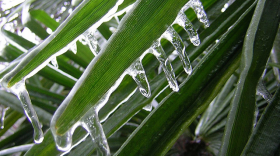The Florida Department of Health in Lee County has issued its fifth health alert this year, four of which have been due to blue-green algae in the Caloosahatchee River.
This week the harmful algae was discovered near North Canal Circle in Lochmoor Waterway Estates, on the north side of the Caloosahatchee River about halfway between the Midpoint Bridge and the U.S. 41 Bridge.
This is in response to water samples taken on April 22.
Large concentrations, called blooms, can change the water color to blue, green, brown, orange, or red. Some cyanobacterial blooms can look like foam, scum, or mats on the surface of freshwater lakes and ponds. As algae in a cyanobacterial bloom die, the water may smell like something with a naturally unpleasant odor has now started to rot, too.
“Blooms have the potential to produce toxins, and what triggers them to do so remains poorly understood,” the Lee County Department of Health wrote in a statement. “Since bloom conditions can change at any time, it is important to exercise caution as if the bloom were toxic, even if toxin presence has not yet been confirmed.”

Different types of blue-green algal bloom species can look different and have different impacts. However, regardless of species, many types of blue-green algae can produce toxins that can make you or your pets sick if swallowed or possibly cause skin and eye irritation.
It’s that time of year. Just over half of the sites tested statewide during the last 30 days have tested positive for blue-green algae.
The year’s fourth warning for pollutants in or near the Caloosahatchee River — issued about two weeks ago — was due to blue-green algae near the Alva Boat Ramp.
The Alva Boat Ramp, and the nearby Davis Boat Ramp, are often places where blue-green algae outbreaks are first noticed. Few become full-blown blooms that spread down the river. At least so far this year.
When there are elements of harmful algae in the water people should not swim in it or waterski, and do not drink it or let the contaminated water splash in your mouth.
Pets are susceptible to blue-green algae, too, so keep dogs and other animals away. If you or your animal gets soaked by water with blue-green algae in it, wash it off thoroughly.

The health department previously has issued two more warnings about blue-green algae in the immediate area around the Alva and Davis boat ramps, one to the north of the river in a canal, and the other just to the west of that.
In February, the health department issued a blue-green algae alert due to blue-green algae blooms in the Southeast 23rd Street canal and along Southeast 11th Place.
Blue-green algae are a type of bacteria that is common in Florida’s freshwater environments. A bloom occurs when the rapid growth of algae leads to an accumulation of individual cells that discolor water and often produce floating mats that emit unpleasant odors.
Some environmental factors contributing to blue-green algae blooms are sunny days, warm water temperatures, still water conditions, and excess nutrients.
Blooms can appear year-round but are more frequent in summer and fall. Many types of blue-green algae can produce toxins.
The first water quality advisory for the year was issued for the Cape Coral Yacht Club, which was heavily damaged by Hurricane Ian 18 months ago, due to unacceptably high levels of the enterococcus bacteria.
Enterococcus bacteria are used as indicators of fecal contamination in water, suggesting the potential presence of disease-causing organisms.
While enterococci are typically not harmful, their presence in water can indicate a health risk for activities such as swimming, as they may be accompanied by pathogens causing illnesses like gastrointestinal issues, skin rashes, and ear infections.
A few days later, the health department issued a notice that retesting found the organism was no longer present near the yacht club at worrisome levels.
Sign up for WGCU's monthly environmental newsletter, the Green Flash, today.
WGCU is your trusted source for news and information in Southwest Florida. We are a nonprofit public service, and your support is more critical than ever. Keep public media strong and donate now. Thank you.








